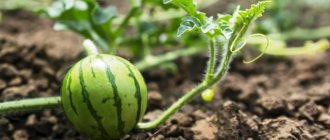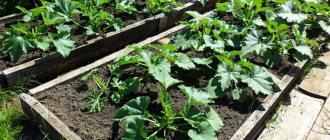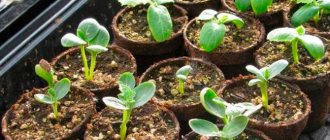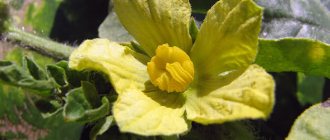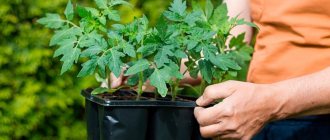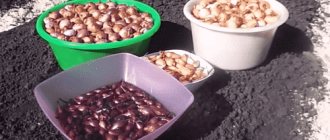Choosing soil for watermelon
Watermelon is a heat- and light-loving plant. You need to choose the sunniest garden bed for it. It grows well in hot and even dry weather. Watermelon has powerful roots that penetrate to a depth of up to a meter and extract the necessary moisture from there. The plant, which is not very large in appearance, requires a lot of free space for comfortable growth. Therefore, there is no need to save on garden beds. When choosing a location, you need to take into account that the plants must be protected from cold winds. At the same time, it is better if it is a small hill where excess water does not accumulate: it has a detrimental effect on the roots, causing fungal diseases.
Watermelon is very picky about the soil composition: it loves light, sandy or loamy soils, with acidity close to neutral (pH 6.5–7). If clay predominates in the area, river sand should be added when digging (1 bucket per m2). Acidic soils should be limed in advance by adding dolomite flour or slaked lime. When choosing a place, you need to know what crops grew here before. The best predecessors: garlic, onions, legumes, cabbage. Watermelon grows poorly after peppers, potatoes and tomatoes. It should not be planted after repeated cultivation of melons. They can grow in one place for a maximum of two years in a row. After this, a five-year break must be provided. Watermelon grows well on virgin lands, since they are quite breathable.
Watermelon will grow anywhere, even overcome weeds, but it is better to provide it with high-quality soil
As with most plants, it is better to prepare a bed for watermelon in the fall. Although there will be an opportunity for this in the spring: watermelon is not planted very early. The area needs to be dug up with a shovel and fertilizer applied. For 1 m2 you need about a bucket of rotted manure or good compost. Fresh manure cannot be used. In the spring, you should go over the bed with a cultivator, first add superphosphate and wood ash (40 g and a liter jar per m2, respectively) and loosen the soil by 10–12 cm. You can also add magnesium-containing fertilizers (about 5 g per 1 m2). You should not add a large amount of nitrogen: an increased content of nitrates impairs both the taste and the preservation of the fruit. If you want the soil to warm up faster, immediately after the snow melts, you can cover the bed with plastic film.
Site preparation
This crop does not place high demands on soil quality. It thrives in black soil, in poor sandstone, and in rocky soil. But it is better to allocate fertile areas for it, then you will be able to grow a rich harvest.
The planting site is prepared in the fall and the following fertilizing is applied:
- wood ash (1 liter per sq.m.);
- azophosphate, superphosphate (according to instructions);
- humus (5 l per sq.m.).
Preparing the soil for planting
This approach allows you to avoid regular application of fertilizers during the active growth of watermelon.
Preparing watermelon seeds for planting
Watermelon can be planted through seedlings and direct sowing in open ground. But the preparation of seeds is the same in both cases. Seeds are not always bought in stores. Sometimes they are taken from a watermelon you like, bought for food. The second case is not very reliable. Firstly, like most crops, watermelon has hybrids (F1). And there is no point in taking seeds from them: the watermelon that was eaten in the summer may grow completely different. Secondly, retail chains do not always sell watermelons that are grown in the appropriate climate. Therefore, it is better to find out which varieties are zoned and buy reliable seeds in a specialized store. If you are planting a watermelon not for the first time and you take the seeds from your harvest, you need to select the largest and tastiest specimens for this purpose.
Watermelon seeds remain viable for 6–8 years.
At first, the seeds can simply be calibrated manually: they are large, so choosing the most respectable specimens will not be difficult.
Watermelon seeds are known to everyone who has ever eaten this berry.
Some hobbyists rub the nose of each seed with sandpaper, making it easier for the root to come out. When planting several specimens, this is easy to do. But in mass production, of course, no one does this.
Disinfection
To disinfect, watermelon seeds are soaked for 20–30 minutes in a dark solution of potassium permanganate (1 g of potassium permanganate per 200 ml of water). Then rinse with clean water. To increase germination, some gardeners soak seeds in solutions of growth stimulants. Actually, pickling in potassium permanganate is really necessary, since it significantly reduces the risk of diseases. And the use of growth stimulants is an optional procedure: good seeds in warm soil already sprout well.
Hardening
When growing watermelon in central Russia, it is advisable to pre-harden the seeds. After disinfection, they are transferred to a damp cloth and placed in the refrigerator for 12–15 hours. It’s even better to wait for the seeds to peck before hardening. To do this, they are kept in a wet cloth until several seeds open and roots appear. It is with the roots that the seeds are placed in the refrigerator. But in this case, the period of “exile” should be shorter: 5–6 hours will be enough. This hardening is a good preventive measure against many diseases. Before sowing, the seeds are slightly dried.
Soak
In fact, when preparing seeds for sowing, we already soaked them in at least a solution of potassium permanganate. If you refuse disinfection and hardening, then you can avoid soaking the seeds at all and plant them dry: the watermelons will sprout. But many gardeners want this to happen a couple of days earlier, and even without treating the seeds, they still soak them in water. It is better to do this two days before planting. First, the seeds should be immersed in hot water (50°C), and after it has cooled naturally, transferred to a wet cloth and kept in it near the radiator, not allowing it to dry out. It is more convenient to do this in a Petri dish. And in the absence of such a container - in any small vessel, not completely hermetically sealed.
A Petri dish is better suited than other vessels for soaking any seeds.
The question of the need for soaking falls into the realm of “laziness.” Most manuals advise soaking almost all vegetable crops. But if everything is done “as written,” a working person will have neither strength nor time left for the rest of his life. Therefore, we often omit operations that seem unnecessary to us. The author of these lines (who lives in Saratov) has never pickled watermelon seeds or soaked them. This is not to say that we always produce good watermelons; this does not happen year after year. But, at least, this does not affect the emergence and growth of the watermelon bush.
Timing for sowing watermelon seeds
The timing of sowing seeds depends on whether it is growing seedlings or directly sowing seeds in a garden bed. Planting seeds in open ground is recommended only for southern regions. An attempt to do this in the Non-Black Earth Region, and even more so in the Urals or Siberia, can lead to the fact that the fruits of even the earliest varieties will have time to set, but will not ripen. The time for planting watermelon seeds for seedlings is 30–35 days before planting in open ground or a greenhouse. In most regions, sowing occurs in mid- or late April. Many varieties have time to ripen even when seeds are sown in the first half of May. Watermelon seeds have a dense shell, so it can take up to ten days for plants to emerge from unprepared seeds.
Rules for planting watermelons
Heat-loving watermelon is cultivated more often in the southern regions of our country. But when grown by seedlings, its early ripening varieties give normal yields in the middle zone. In central regions, watermelons are often grown in greenhouses. The minimum temperature for germination of watermelon seeds is 16°C. At 0°C plants die. The most favorable temperature is 20–30°C.
Based on the climate of the region, it is possible to plant watermelon in open ground or only in a greenhouse. But in both cases it is possible to grow it either through the seedling stage or simply by sowing seeds in a garden bed. Therefore, the choice of method of planting watermelon is quite wide. Planting patterns, that is, ways of placing plants in the provided space, also differ.
At what distance to plant watermelons
Different sources provide different watermelon planting schemes. But all authors agree on one thing: watermelon needs a lot of space, and dense plantings are unacceptable. Based on the geometry of the site and the preferences of the owner, both line (row) and square-cluster planting are possible. When planting in rows, 1.5 to 3 meters are left between rows of watermelons, and about 1 meter between plants in a row. When planting in square nests, it is recommended to leave distances between holes from 0.7 to 2 meters, depending on the variety of watermelon and the power of the plant.
Considerable distances are always left between watermelon bushes
Of course, these distances relate, rather, to the mass production of watermelons, to sowing them in a large field. An ordinary summer resident will plant no more than a dozen plants in a small garden bed, but the distance between them still cannot be less than half a meter.
In closed ground (in a greenhouse), you usually cannot afford such luxury, and the distances have to be made somewhat smaller. Most often, a 50 x 70 cm scheme is used. In the case of early varieties, two plants are planted in a hole, directing their lashes in opposite directions as they grow.
Sowing seeds for seedlings at home
When sowing watermelon seeds for seedlings, you should expect that they will be planted in open ground or a greenhouse in about a month. The best soil mixture for seedlings consists of equal parts of turf soil, sand, peat and humus. You can also add sawdust. It is also allowed to sow in a common box, but transplanting watermelons from a common container into the ground will be very painful for the seedlings. It is better to take a separate container for each plant with a volume of 200 ml or more, with a depth of at least 10–12 cm. Peat pots are optimal.
Sowing is carried out to a depth of about 3 cm, 2-3 seeds per pot, and a little clean sand is poured on top. Before sowing, the soil is slightly moistened. And after sowing, the pots are covered with glass or plastic film, creating a greenhouse effect until the first shoots appear. The optimal temperature for growing seedlings is 22°C during the day and 18°C at night. But immediately after the emergence of seedlings, it is lowered by 3–5 degrees for several days. Watering is needed moderately, at the root. Sometimes you have to highlight the seedlings, especially if they are trying to stretch out. Daylight should be about 12 hours.
Already at the seedling stage, each watermelon plant requires a rather large home.
A week after germination, one plant at a time is left in the pot. At this time, the seedlings can be slightly fed with complex fertilizer or mullein infusion. A week before planting in the ground, the seedlings are hardened off. By the time it is planted in the garden, it should have 4–5 true leaves.
Video: sowing watermelon seeds for seedlings
Planting seedlings in open ground
Of course, greenhouse conditions are better suited for growing watermelon in the middle zone. But in more southern regions they ripen well in open ground. The grown seedlings are planted in the garden bed as follows:
- In the places designated according to the chosen scheme, dig holes with a scoop slightly larger than the size of the pots with seedlings.
- A glass of wood ash is poured into each hole as a local fertilizer, mixed with soil and watered a little.
- Carefully removing the pre-well-watered seedlings from the pots, transfer them to the holes and deepen them a little. All leaves should remain on the surface.
- Carefully water each plant at the root.
- Then pour a centimeter layer of clean sand around the stem.
Harvesting and storage features
The fruits begin to ripen approximately 40 days after pollination.
If the watermelons do not ripen before the onset of cold weather, they are removed from the garden and stored in a cool room where ripening continues. The ripeness of watermelons is determined by the ringing sound when tapped and the dry tail. When you squeeze a ripe fruit, you can hear a slight crackling sound in the pulp. A yellow spot on the side also indicates ripeness.
Depending on the variety, watermelons can be stored for up to three months. The fruits tolerate transportation well.
Caring for watermelons
Watermelon is a drought-resistant crop and does not require abundant watering. It is necessary to water only before fruit set, especially during the period of intensive leaf growth. During fruit ripening, to increase sugar content, the soil, on the contrary, is slightly dried. Watermelon is very light-loving, especially in the first months of development. The main activities at the melon farm come down to the following activities:
- moderate watering. Until fruit set, the soil should be constantly moist, but not swampy. Watering is best done in the evening, watering at the roots. After moistening the soil, loosening is required;
- weeding. In this, watermelon is no different from most garden dwellers. As it grows, it itself begins to suppress the development of most annual weeds;
- the location of the lashes in the garden bed. They must be periodically rearranged so that they do not intertwine with each other;
- fertilizing The first is 7–10 days after planting the seedlings in the garden. The second one is in another month. It is better to use infusions of organic fertilizers with the addition of ash; if not, use azophoska strictly according to the instructions on the package. Feeding should be stopped after fruit formation begins;
- artificial pollination. It may be needed when growing watermelons in a greenhouse. If insects do not fly into it, you need to pollinate the flowers manually using a regular brush;
- plant formation. No more than 5 fruits are left on the bush. Excess side stems must be pinched.
- protection from rotting. As watermelons grow, it is worth placing plywood under these berries to prevent possible rotting in case of rainy weather.
Preventive spraying
Watermelon is an unpretentious plant. With proper agricultural technology, it is rarely susceptible to diseases or pest invasions. To prevent possible diseases, various drugs are used, such as Fundazol, Decis, Bordeaux mixture. Each of them is intended to treat specific diseases, so you must read the instructions before use.
Watermelon has few pests. To combat aphids, plants are sprayed with infusions of ash or tobacco dust, after which the soil is loosened. Wireworms and various caterpillars are collected using sweet baits placed in small holes. To repel most insects, spraying watermelons with folk remedies is sufficient. These can be infusions of garlic, mustard, wormwood, hot pepper, tobacco dust, tomato tops. Treatment is carried out once a week.
Pests of watermelons and melons
| Name | Harm caused | Way to fight |
| Aphid | Colonies of these insects are located on the leaves and destroy the ovaries and flowers. Aphids spread especially actively when the weather is warm and fairly humid. | Garlic, onion or mustard infusion gives good results. To prepare it, 300 gr. add a bucket of water to the onion and leave overnight. Then the product is filtered and the affected plants are treated. |
| Wireworm | These pests are small brownish worms covered with a hard shell. They live in the soil and cause severe damage to the root system. | Wireworms live on the roots of perennial weeds, so it is important to weed the area in a timely manner. Plants such as mustard greens or beans repel them well. |
| Fall armyworm | It develops in two generations, the caterpillars overwinter in the soil, rise to the surface in the spring, and pupate in the upper layers of the soil. At the end of May, the butterflies begin their flight, which lay eggs from which caterpillars grow. | The armyworm is a nocturnal insect, so you need to collect their caterpillars at night using a bucket of soapy water. You need to do this all summer, twice a week. |
| Spider mite | The tick loves dry, hot weather. It affects the leaves, on which light-colored spots appear. | You should carefully inspect the leaves. If affected areas are found, they must be removed and burned. |
Features of planting watermelon in different regions
The main difference in climatic conditions between regions, from the point of view of growing watermelons, is the number of warm summer days. This is what leaves an imprint not only on the conditions for caring for plants, but also on the method of planting them in beds. Growing watermelons is extremely difficult only in regions with a harsh climate, for example, in Siberia.
In central Russia
In the climatic conditions of the middle zone, watermelons should be grown in open ground through seedlings. It is most convenient to use peat pots for it. You can plant them in the garden at the end of spring. But quite often they also practice greenhouse cultivation, where seedlings are planted in early May. It is almost impossible to grow watermelon here without seedlings, without using greenhouses: this can only be done in certain, most favorable seasons.
Recommended varieties: Ogonyok, Skorik, Sibiryak. When forming plants, you should not leave more than two fruits on each vine. If the summer is rainy, even two watermelons on a vine may not have time to ripen properly. And they will not taste sweet - such watermelons are often used for pickling.
The best varieties of watermelons with characteristics
Thanks to the painstaking work of breeders, today watermelons can be grown not only in the southern regions, but also in the Urals and Siberia. In order for the plant to grow healthy, and for the fruits to be large, juicy and sweet, it is important to take care of proper care of the melon crop. And before planting watermelons, you need to choose the right variety. The most popular varieties most often preferred by farmers are:
- “Ogonyok” is an early-ripening type of melon crop. Harvest can be done 71–80 days after planting the seeds. The weight of the fruit reaches 1.7–2.2 kg. The variety is unpretentious. The tender and juicy pulp is colored orange-red.
- “Podmoskovny Charleston F1” is an early-ripening hybrid whose fruits are large in size. The bright red flesh delights with a sweetish taste. The dark green rind is shiny and smooth. The weight of watermelons is in the range of 7–10 kg.
- "Skorik" is a mid-early variety. Harvesting can be done 90–100 days after planting the seeds. The shape of the fruit is spherical, the weight reaches 2–4 kg. The aromatic pulp is juicy and sweet.
- "Crimlong F1". Watermelons have an elongated shape. The weight of the fruit is 9–10 kg. The peel is quite strong, so the crop can be transported over long distances. The variety is resistant to fusarium and anthracnose.
- "Florida F1" is a mid-early, high-yielding variety. The weight of the fruit is in the range of 4–8 kg. The shape of watermelons is elongated, the stripes on the peel are blurred.
- “Rafinad” is a mid-early variety of melons, the spherical fruits of which are painted in a gray-green marble palette. The weight of watermelons reaches 4 kg.
- “Big Sugar” is one of the most popular varieties. Harvesting can be done 90 days after planting the seeds. The weight of rounded fruits reaches 10–11 kg. The sugary and juicy pulp is colored in raspberry tones.
Advice! When choosing a variety, it is necessary to take into account the region in which you plan to grow watermelons.

